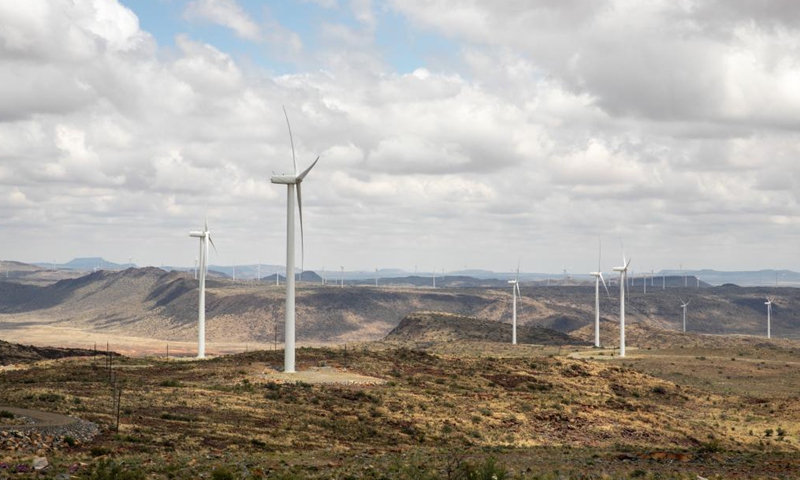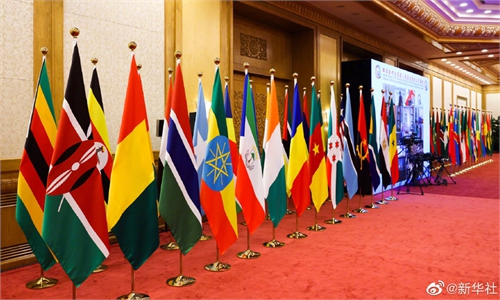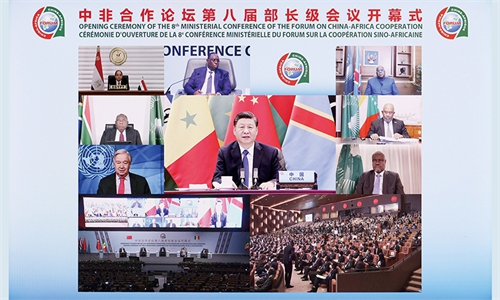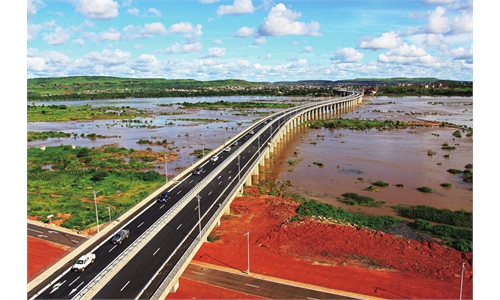Beijing to provide cutting-edge tech to Africa on climate change, outlines promising, practical ties

Photo taken on Nov. 22, 2021 shows wind turbines of the De Aar wind power project invested by China's Longyuan Power and its South African partners in De Aar, South Africa.Photo:Xinhua
China and Africa have pledged to deepen cooperation on climate change in a joint declaration, announcing a slew of cutting-edge technologies to be provided by China to help Africa address climate change-related issues.
Experts hailed the partnership as promising and practical, and urged the US and other developed countries to do more than lip service, provide funds, open up technology restrictions, and stick to their promises.
The two sides passed a declaration on climate change cooperation on Tuesday during the 8th Ministerial Conference of the Forum on China-Africa Cooperation (FOCAC).
The two sides pledged to build a China-Africa strategic partnership on climate change in the new era, where they will broaden areas of cooperation including in clean energy, the use of aerospace technology in addressing climate issues, agriculture, forestry, low-carbon infrastructure construction, meteorological monitoring and forecasting, and disaster mitigation.
China will support Africa's Great Green Wall movement by deploying cutting-edge technologies to improve the continent's abilities in disaster relief and swift adaptation to climate change, including the China High-resolution Earth Observation System (CHEOS), BeiDou Navigation Satellite System (BDS), and Fengyun weather satellites.
China's aerospace technologies have already been widely applied to help Africa in meteorological monitoring and climate change adaptations.
When Tropical Cyclone Idai, one of the worst on record to affect Africa and the Southern Hemisphere, landed in Mozambique, Zimbabwe and Malawi in March 2019 that triggered a series of secondary disasters such as flash floods, mudslides and landslides, China's Fengyun meteorological satellites provided real-time tracking and monitoring of the disasters, and provided a weather application platform to the affected countries.
As early as 2013, China had started to implement meteorological assistance to countries such as Comoros, Zimbabwe, Kenya, Namibia, Cameroon, and Sudan. China has built 42 sets of automatic weather stations, 100 sets of artificial weather observation systems, five sets of lightning locators, two sets of Fengyun-3 satellite data reception and processing systems, and over 10,700 weather warning radios. China had also sent professional personnel to Africa to install and debug the equipment and trained locals, China Pictorial reported.
China has implemented over 100 clean energy projects in Africa, supporting the continent to make better use of its solar energy, hydroelectric power, wind energy, biogas and other renewable energy sources, the declaration said.
Lin Boqiang, director of the China Center for Energy Economics Research at Xiamen University, told the Global Times on Thursday that climate change cooperation between China and Africa is very promising, as Africa has the rich natural resources in clean energy, such as sufficient sunlight and wind, while China has the needed technology of wind and photovoltaic power generation, and electric vehicles to support the cost-efficient use of these resources.
"While the West has the funds and technologies to realize carbon emission goals, they are all too costly and impractical for African countries. However, China, as the largest developing country in the world, has found a different path to achieve the target more suitable for the developing world."
The declaration further stressed the need for developed countries to fulfill their funding obligations to help developing countries, especially African countries, to cope with climate change, and strive to fill the gap with the pledged $100 billion per year by 2020 as soon as possible.
Failing to deliver on its promises, US climate envoy John Kerry, however, said on Wednesday that big greenhouse gas emitting countries like China, India, Russia, South Africa and others must move faster to help the world avert the worst impact of global warming, Reuters reported.
He said that pledges by governments in these countries to cut carbon dioxide and methane emissions are "insufficient," adding that Washington was engaging with some of these developing countries to help them reduce emissions, including the joint agreement with China signed last month.
Zhou Dadi, Director of Energy Research Institute under the China Institute for Innovation and Development Strategy, pointed out that despite China and the US signing many protocols on climate change cooperation, many of them were given up halfway with the change in the US government.
More concrete cooperation, especially on technologies, should be given greater attention as the two countries face similar challenges on low-carbon transition, the Global Times learned at the 2021 Understanding China Conference (Guangzhou) on Thursday.
However, the US is setting many barriers on technology sharing. "Backward technologies cannot solve the problem of low carbon transition; thus, China and the US should not engage in independent, divided and closed competition," Zhou said.
"China is not afraid of a blockade. In terms of traditional innovation methods, the more blocked areas there are, the more likely China will eventually develop them by itself. However, such an approach, in which each country demarcates its own market and goes its own way, will reduce its competitiveness, comparability and selectivity," Zhou said.
In an article published by the Chinese Academy of Social Sciences, Chinese researchers urged more attention to the impact of climate change on Africa. While Africa emits only less than 5 percent of the world's total greenhouse gas emissions, it bears the greatest burden in terms of associated impact, it said.
From 1951-2020, the continent's temperatures have risen faster than the global average, and are expected to experience more extreme hot weather and more frequent and intense precipitation. The International Monetary Fund estimated that sub-Saharan Africa has suffered direct economic losses of more than $520 million per year since the turn of the 21st century due to climate change.




